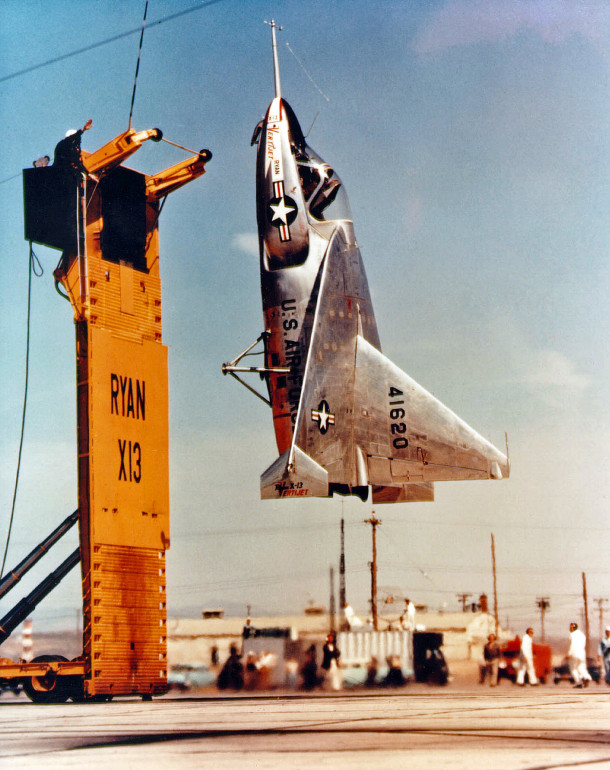
Sixty-two years ago this month, the USAF/Ryan X-13 Vertijet completed history’s first vertical-to horizontal-back to vertical flight of a jet-powered Vertical Take-Off and Landing (VTOL) aircraft. This event took place at Edwards Air Force Base, California with Ryan Chief Test Pilot Peter F. Girard at the controls.
The X-13 Vertijet was an experimental flight vehicle designed to determine the feasibility of a jet-powered Vertical Take-Off and Landing (VTOL) aircraft. The initial idea for the type dates back to 1947 when the United States Navy (USN) put Ryan under contract to explore the viability of a jet-powered VTOL aircraft. At the time, the Navy was quite interested in exploiting the VTOL concept for tactical advantage. The service envisioned basing VTOL aircraft on submarines and small surface ships.
The USN-Ryan team worked the X-13 VTOL concept for over six (6) years to good effect. While no flight vehicle took to the skies during that time, a great deal of progress was made in the realm of hovering flight using ground-based vertical test rigs. Particular effort was focused on VTOL low-speed flight controls. However, Navy research and development funding was slashed in the aftermath of the Korean War and the X-13 project ran out of money in the summer of 1953.
Fortunately, the United States Air Force (USAF) had become interested in the X-13 and the possibilities of VTOL flight prior to the Navy running out of money. The junior service assumed ownership of the X-13 effort after securing the funding required to continue the program. A pair of X-13 prototypes were subseqently built and flown by Ryan Aeronautical. These aircraft were assigned USAF serial numbers 54-1619 and 54-1620, respectively.
The X-13 measured 23.5 feet in length and had a wing span of 21 feet. The single-place aircraft featured a maximum take-off weight of approximately 7,300 pounds. Hovering flight control was provided via wing tip-mounted yaw and roll nozzles. The heart of the VTOL aircraft was its reliable Rolls-Royce Avon turbojet. The non-afterburning powerplant used standard JP-4 fuel and produced a maximum thrust of 10,000 pounds.
The X-13 was transported, launched and retrieved using a special flatbed trailer. Hinged at one end, the trailer was raised and lowered through the instrumentality of a pair of hydraulic rams. Once raised to a vertical position, the X-13 hung on its nose hook from a steel suspension cable stretched between two mechanical arms. Rather than landing gear, the aircraft sat on two non-retractable tubular bumpers positioned on the lower fuselage.
Flight testing of the No. 1 X-13 (S/N 54-1619) began on Saturday, 10 December 1955 at Edwards Air Force Base, California. The purpose of this initial flight was to test the X-13’s conventional flight characteristics. The aircraft was configured with tricycle landing to permit a runway take-off. Ryan Chief Test Pilot Peter F. “Pete” Girard flew a brief seven minute test hop in which he determined that the X-13 had serious control issues in all 3-axes. The subsequent installation of yaw and roll dampers fixed the problem.
The next phase of flight testing involved vertical hovering flight wherein aircraft handling and control characteristics were explored. For doing so, the X-13 was outfitted with a vertical landing gear system composed of a tubular support structure and a quartet of small caster-type wheels. Thus configured, the X-13 could take-off, hover and land in the vertical. As vertical flight testing progresed, important refinements were made to the aircraft’s turbojet throttling and reaction control systems.
The first vertical flight test was made on Monday, 28 May 1956 with the No. 1 aircraft. Pete Girard was again in the cockpit. Restricting maximum altitude to about 50 feet above ground level, Girard found the aircraft relatively easy to fly and land. Succeeding flight tests would ultimately include practice hook landings wherein a 1-inch thick manila rope suspended between a pair of 50-foot towers was engaged. A great deal of experience with and confidence in the X-13 system was accrued during these tests.
Prior to flying the X-13 all-up mission, an additional phase of flight testing was required which would culminate with the events of Monday, 28 November 1956. With the conventional landing gear installed on the No. 1 aircraft, Girard took-off from Edwards and climbed to 6,000 feet. He then slowly pitched the aircraft into the vertical and hovered for an extended period. Girard then executed a transition back to horizontal flight and landed. The first-ever horizontal-to vertical-back to horizontal flight transition was entirely successful.
The big day came on Thursday, 11 April 1957. Edwards Air Force Base again served as the test site. This time using the No. 2 X-13 (S/N 54-1620), Pete Girard took-off vertically, ascended in hovering flight and transitioned to conventional flight. Following a series of standard flight maneuvers, Girard transitioned the aircraft back into a vertical hover, descended and engaged the suspension cable on the support trailer with the aircraft’s nose hook. The first-ever vertical-to horizontal-back to vertical flight of a jet-propelled VTOL aircraft was history.
Both X-13 aircraft would go on to successfully conduct additional flight testing and stage numerous flight demonstrations during the remainder of 1957. However, innovative and impressive as it was, the X-13 did not garner the advocacy and backing required to proceed to production. A combination of bad timing, a risk averse military and combat performance limitations resulted in the aircraft and its technology quickly fading from the aviation scene.
Remarkably, both X-13 aircraft survived the type’s flight test program. The No. 1 aircraft (S/N 54-1619) is displayed at the San Diego Aerospace Museum in San Diego, California. The No. 2 X-13 aircraft (S/N 54-1620) is on display in the Research and Development Gallery of the United States Air Force Museum at Wright-Patterson Air Force Base in Dayton, Ohio.
